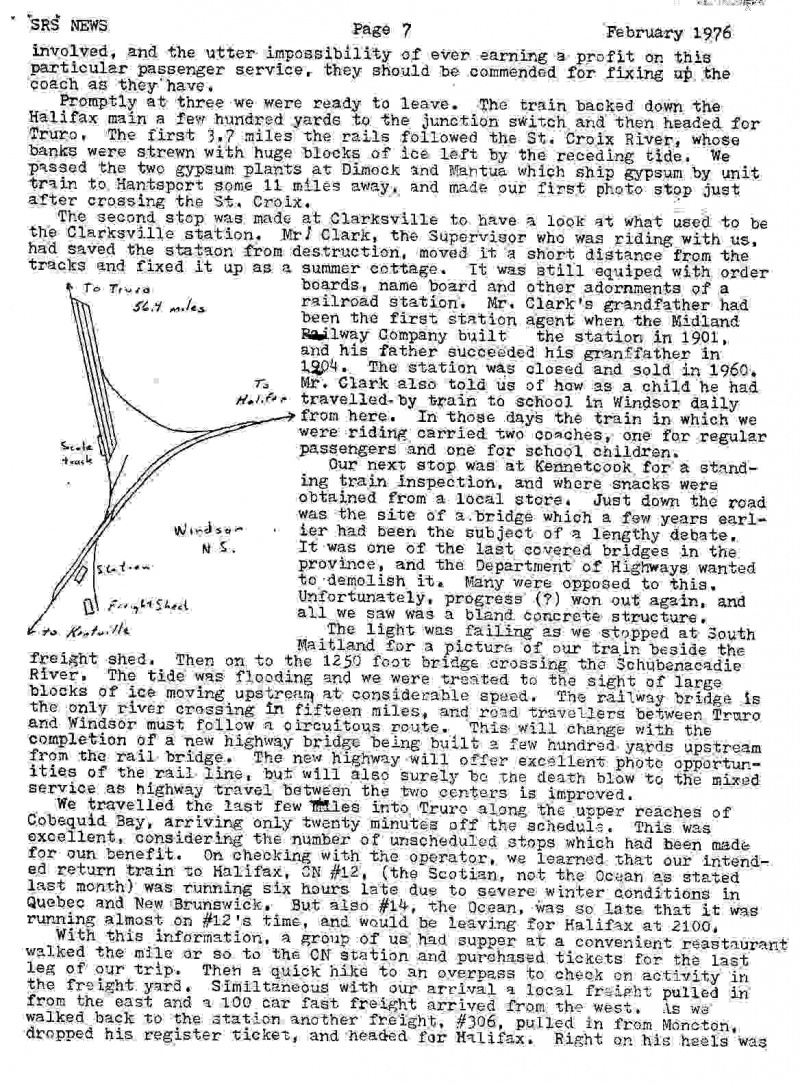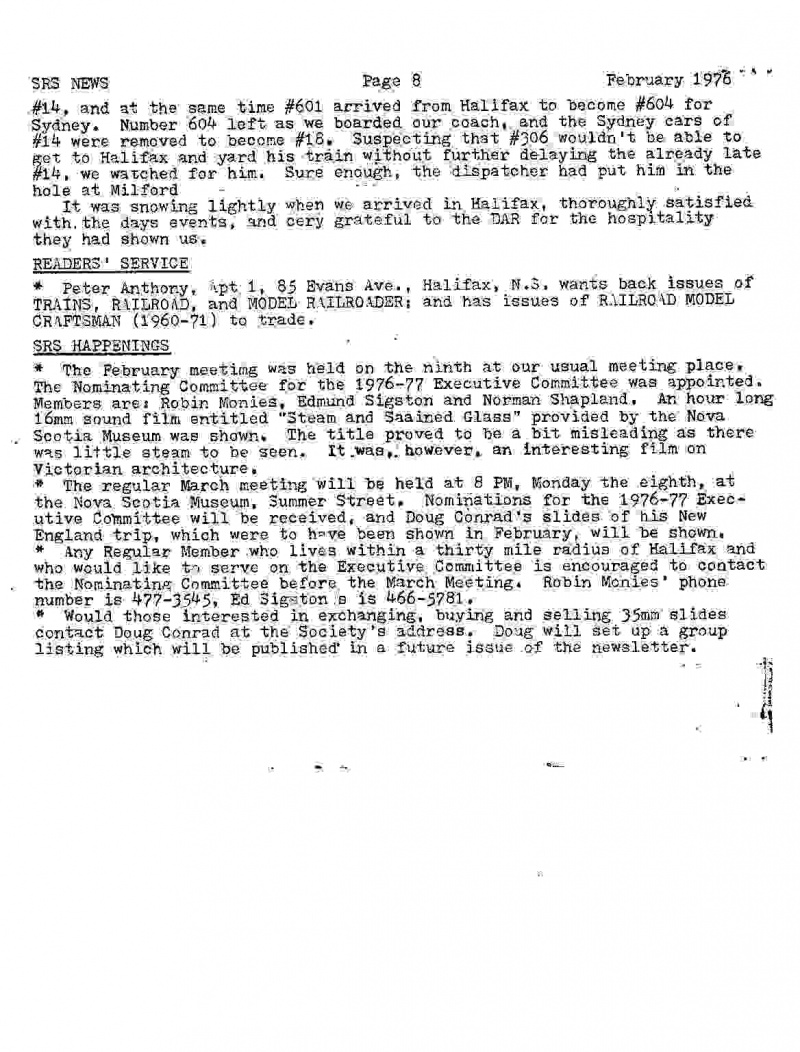Dominion Atlantic Railway Digital Preservation Initiative - Wiki
Use of this site is subject to our Terms & Conditions.
Scotian Railroad Society 1976-02 News - Halifax - Windsor - Truro - Halifax Excursion
Scotian Railroad Society - News February 1976
Scotian Railroad Society members ride the Dayliner from Rockingham to Windsor, the Mixed to Truro, and the Ocean back to Halifax. A transcription of the article text (not including captions) is below the pages of the article for ease of reading and for search purposes.
Reference Tag
Please use this tag when referring to this article: Scotian Railroad Society, News February 1976
A DAY ON THE MIDLAND -- Gary Pollock
Saturday, January 24th, dawned clear and crisp after the coldest night of the winter, (-20C) but the weatherman was promising moderate daytime temperatures and lots of sunshine. As our group waited at Rockingham for DAR #1 we watched CN Express 212, powered by a pair of 2000 series M-630's, set out several piggyback flats before continuing on to Ocean Terminal, Just as the express pulled out Dayliner 9062, with Conductor George Gilles and Engineer John DeWolfe, came into view, and glided to a stop in response to the green and white flag fluttering beside the track. A quick count after boarding showed that, including those who had got on downtown, our group numbered 19 and that there were about a dozen other passengers aboard.
Conversation with the conductor revealed that the Dayliner had hit and killed a deer on its early morning run from Yarmouth, and also alerted us to a daily ritual that was to be enacted near Stillwater. (Mile 19.5) In a small house near the tracks lives an old Indian and his dog. Each morning on the return run from Halifax the train crew tosses off a tightly rolled newspaper which the dog retrieves and takes to the house. The commotion within the house is left to your imagination as the train approaches at 40 to 50 mph giving several toots on the air horn to announce its approach, the door flies open and a fairly large dog dashes from the house to get his paper. Last Christmas the crew bought some dog food and other goodies and stopped to hand the package to the dog. The change in ritual was greeted with some loud snarls until some sniffing of the package, which was gingerly presented, reassured the dog and he accepted it.
Arriving at Windsor on time (1046) we checked with the operator on the progress of Train 22 from Truro. He was expected in Windsor at 1230, so coffee at a Water Street restaurant seemed: in order. (The main line used to run down the middle of the street in front of this restaurant.) After coffee a scouting of the yard to the southeast of the station revealed a number of empty gypsum ore cars and the caboose from the gypsum train, the engines for this train having gone on to Kentville for the weekend.
Shortly after 1230, Train 22 with engine 8134 arrived with 15 loads and 5 empty ore cars, The empties had been used as idlers to spread the weight of the train for two bridge crossings. The coach was cut off, (two passengers, both youths) and pulled down to the station. Then the crew went about their local work. The five empties were set out, and also one bulbous grain car which would have to be left or the train would exceed its tonnage for the run to Kentville, a load of cattle was picked up and left on the scale track for Train 21, and a local industry was switched.
Train 24 from Kentville, engine 8131, with one empty grain car and caboose arrived at about 1345 and commenced his local work. Empties from the yard were spotted at a local industry, one loaded boxcar and the cattle car was picked up, and Train 21's consist of three freight cars, caboose and coach was assembled. The Conductor would be Gordon Young and Engineer, Allen Russell.
Gathering in front of the station at 1445, we met Mr. E.W. Purssell, Manager of the D.A.R., who had come up from Kentville to meet us, and Mr. John Clark, Rail Terminal Supervisor, who would be travelling with us to arrange photo stops. Inspection of the coach revealed that it was originally number 1437, built in CP's Angus Shops in 1928. The Baker Heater was still intact, although not used. Instead, two oil heaters provided warmth. A shock, to a railfan, was the seats. Some time earlier vandals had broken into the coach and smashed all the plush seats, The DAR had replaced them with the only thing locally available, school bus seats. The railway has taken quite a few knocks for doing this, but when you consider the cost involved, and the utter impossibility of ever earning a profit on this particular passenger service, they should be commended for fixing up, the coach as they have.
Promptly at three we were ready to leave. The train backed down the Halifax main a few hundred yards to the junction switch and then headed for Truro. The first 3.7 miles the rails followed the St. Croix River, whose banks were strewn with huge blocks of ice left by the receding tide, We passed the two gypsum plants at Dimock and Mantua which ship gypsum by unit train to Hantsport some 11 miles away, and made our first photo stop just after crossing the St. Croix.
The second stop was made at Clarksville to have a look at what used to be the Clarksville station. Mr. Clark, the Supervisor who was riding with us, had saved the station from destruction, moved it a short distance from the tracks and fixed it up as a summer cottage. It was still equipped with order boards, name board and other adornments of a railroad station. Mr. Clark's grandfather had been the first station agent when the Midland Railway Company built the station in 1901, and his father succeeded his grandfather in 1904. The station was closed and sold in 1960. Mr. Clark also told us of how as a child he had travelled by train to school in Windsor daily from here. In those days the train in which we were riding carried two coaches, one for regular passengers and one for school children.
Our next stop was at Kennetcook for a standing train inspection, and where snacks were obtained from a local store. Just down the road was the site of a bridge which a few years earlier had been the subject of a lengthy debate. It was one of the last covered bridges in the province, and the Department of Highways wanted to demolish it Many were opposed to this. Unfortunately, progress (?) won out again, and all we saw was a bland concrete structure.
The light was failing as we stopped at South Maitland for a picture of our train beside freight shed. Then on to the 1250 foot bridge crossing the Schubenacadie River. The tide was flooding and we were treated to the sight of large blocks of ice moving upstream at considerable speed. The railway bridge is the only river crossing in fifteen miles, and road travellers between Truro and Windsor must follow a circuitous route. This will change with the completion of a new highway bridge being built a few hundred yards upstream from the rail bridge. The new highway will offer excellent photo opportunities of the rail. line, but will also surely be the death blow to the mixed service as highway travel between the two centers is improved.
We travelled the last few miles into Truro along the upper reaches of Cobequid Bay, arriving only twenty minutes off the schedule. This was excellent, considering the number of unscheduled stops which had been made for our benefit. On checking with the operator, we learned that our intended return train to Halifax, CN #12, (the Scotian, not the Ocean as stated last month) was running six hours late due to severe winter conditions in Quebec and New Brunswick. But also #14, the Ocean, was so late that it was running almost on #12's time, and would be leaving for Halifax at 2100.
With this information, a group of us had supper at a convenient restaurant walked the mile or so to the CN station and purchased tickets for the last leg of our trip. Then a quick hike to an overpass to check on activity in the freight yard. Simultaneous with our arrival a local freight pulled in from the east and a 100 car fast freight arrived from the west, As we walked back to the station another freight, #306, pulled in from Moncton, dropped his register ticket, and headed for Halifax. Right on his heels was #14, and at the same time #601 arrived from Halifax to become #604 for Sydney. Number 604 left as we boarded our coach, and the Sydney cars of #14 were removed to become #185. Suspecting that #306 wouldn't be able to get to Halifax and yard his train without further delaying the already late #14, we watched for him. Sure enough, the dispatcher had put him in the hole at Milford.
It was snowing lightly when we arrived in Halifax, thoroughly satisfied with the days events, and very grateful to the DAR for the hospitality they had shown us.



